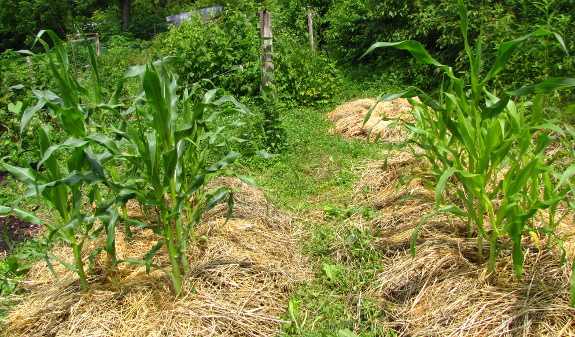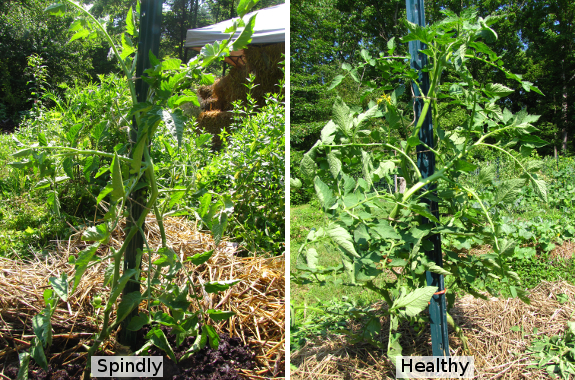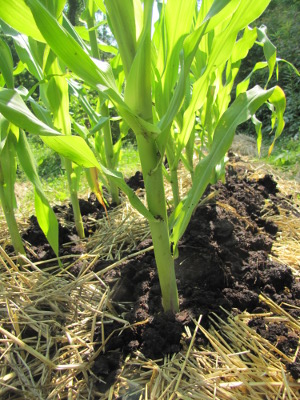
Nitrogen deficiency

After sunlight and
water, nitrogen is the most common factor limiting plants'
growth. Can you see how the corn plants on the right have leaves
a shade yellower than the ones on the left? These yellow-green
leaves are a sure sign of nitrogen deficiency, in this case due to the spring
cover crops eating
up the compost and not rotting fast enough to give that nitrogen back
to the corn.

Or take a look at the
tomatoes above. The two are the same variety, started from seed
at the same time, but when I transplanted the tomato on the left into
an old hugelkultur
mound, I forgot to add any compost. The plant looks okay
color-wise but is spindly (which can also be a sign of too much shade,
though not in this case.) It's a bit tough to tell from the
photo, but the healthy tomato is half again as tall and twice as bushy
as its nitrogen-starved sibling...and that's after I cut off about half
of the plant's bulk in a severe pruning just before taking the picture.

Luckily, a nitrogen
deficiency is extremely easy to fix. First, I look at the problem
short term and find a way to give the plants a dose of liquid
fertilizer. I opted to water
down some urine and
pour it into the soil around the troubled plants' roots, but you could
also make some compost or manure tea.
The next step is to
solve the problem long term by top dressing around the plants with
nitrogen-rich compost. Cover the compost up with a little extra
mulch and
I'm all done. No more nitrogen deficiency on our farm!
Want more in-depth information? Browse through our books.
Or explore more posts by date or by subject.
About us: Anna Hess and Mark Hamilton spent over a decade living self-sufficiently in the mountains of Virginia before moving north to start over from scratch in the foothills of Ohio. They've experimented with permaculture, no-till gardening, trailersteading, home-based microbusinesses and much more, writing about their adventures in both blogs and books.
Want to be notified when new comments are posted on this page? Click on the RSS button after you add a comment to subscribe to the comment feed, or simply check the box beside "email replies to me" while writing your comment.

Because It Works.
Of course as proof you should publish the results of your nitrogen donations.
Unlike the biochar, urine fertilization experiments don't seem to lend themselves very well to taking real data in our garden --- I just pour on the pee when I think something needs a boost. However, I did take a followup photo of the corn so you can see for yourself how well my nitrogen applications worked. The photo in the post above was taken on July 20, and I just took the photo below one week later.
To my eye, the color is nearly back to normal in the second photo, although the corn is a bit behind the other bed still development-wise. Looks like success to me!